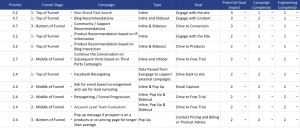
How many accounts can one AM handle at your agency? Consider these 16 factors.
An email subscriber asked me: “How many accounts or clients can one person handle? I limit mine to three at any one time. But maybe there is a better way of determining how many projects I could carry.”
Like many questions about agency growth… it depends. Typically 4-8 accounts per person. But it could be 20 accounts per person… or just 1 account per person.
Let’s look at the factors, to help you find the answer at your agency!
16 Factors: How Many Accounts Can They Handle?
Here are key factors to consider on client account management workload, as you decide what’s right for your agency—and for each role, and for each person in the role.
- Broad vs. Focused Role: If someone is solely an Account Manager (that is, they aren’t also doing fulfillment), they can typically handle 4-8 accounts. If someone is solely a Strategist (that is, they aren’t also a day-to-day client contact), they can handle 8-12 clients. Here’s more on the six Agency Roles. It’s hard to switch between tasks when someone is doing AM, PM, Strategy, and/or Subject Matter Expert (SME) work.
- Client Budget: Budget counts. If a client is spending $ 100,000 a month on services, they might be just one or two clients for their AM. If a client is spending $ 5,000 a month, the AM might have eight clients. Some of that also depends on how much you’re paying the AM, too—for instance, $ 60,000 versus $ 120,000. In general, plan on allocating 20-25% of the client budget to AM and PM.
- Client Neediness: Regardless of budget, an AM might be able to handle 6-8 easy-going clients… or just 2-3 needy clients. If client neediness continues, consider some “strategic churn“… or you might end up losing your employees, instead.
- Service Level: An agency providing productized services to small businesses might run requests through a support ticketing system, while an agency doing expensive custom work might limit their client workload to provide a boutique client experience. If someone on your team is the “maintenance and support” person (handling one-off requests from past clients), they could potentially handle inquiries from 20-50 accounts, if each client rarely reaches out… and has low expectations on the support experience. What’s in your agency’s service level agreement (SLA), whether specific or implied?
- Client Complexity: Separate from budget and service level, how complex is the client? If you work with multiple departments at a single client organization, each department is technically a “client.” I had this in the past, where we had multiple clients within a university—we received payments from a single place, but we treated each department as a separate client.
- Billable Target: An AM or PM will ideally bill around 20 hours a week. They can get that to 25 hours a week… but significantly more means they’ll be working long weeks. Look at each employee’s billable load—if they’re already on-target, it’ll be hard to take on more clients without requiring a longer week every week.
- Agency Structure: An AM in a pod structure might handle more accounts, because the rest of their team is “static”—everyone in their pod handles the same clients. This makes it easier for someone to pop in to help, versus needing to share context on the entire situation.
- Meeting Frequency: Are you doing monthly meetings or weekly meetings? Client meeting frequency impacts how many clients one person can handle, because 10 one-hour meetings a week (plus prep and follow ups) mean they have just 20 hours left to do the rest of their work.
- Client Onboarding Frequency: How often are you onboarding new clients? Client onboarding tends to be time-consuming. If an AM is onboarding a new client every couple weeks (while keeping their existing client load), their workload will quickly explode. Consider what would happen if the trend continues.
- Employee Experience: Your senior employees can likely handle more accounts at once than your junior employees, because the seasoned team members have more experience handling client issues.
- Nature of the Work: Are you doing highly-complex work that requires multiple people, or does your work lend itself to one person doing everything? At PR agencies, people tend to do multiple roles (e.g., AM, PM, Strategy, and SME). This tends to mean they ideally handle fewer clients at once. I also see this at PPC agencies, where a PPC strategist might do AM, PM, and SME work.
- SOW Clarity: How clear is the Statement of Work (SOW)? That is—separate from your SLA, what have you committed to do? And what’s not in the SOW? If your AM doesn’t know what’s in the scope—or the SOW is vague—it’s harder to avoid scope creep. And [unmanaged] scope creep leads to less capacity to handle truly-billable work.
- Admin Support: If an Account Manager has an Account Assistant or a Project Coordinator supporting them on details, the AM can handle more accounts. If the AM has to do everything themselves, they can’t handle as many clients.
- Sales Support Workload: If an AM or Strategist is also doing a lot of sales support—for instance, attending sales meetings, doing scoping, or otherwise assisting in the sales process—they can’t handle as many current accounts.
- Managerial Responsibilities: The more people someone manages, the less bandwidth they have to manage clients directly. Your VP of Accounts might oversee 20 accounts… but they aren’t the day-to-day contact for all of them, or potentially even any of them. This means they can help the AMs troubleshoot problems that pop up.
- Owner Priorities: As agency owners, most of my clients want to reduce or eliminate their day-to-day client responsibilities. After a few years of being in business, they typically want to do strategy for their agency’s largest clients… or no client-facing work at all. But that means someone else needs to get things done.
Business & Finance Articles on Business 2 Community
(80)
Report Post








